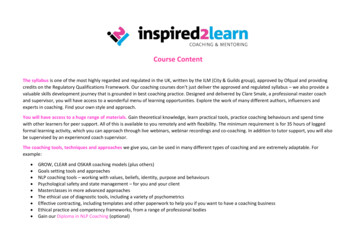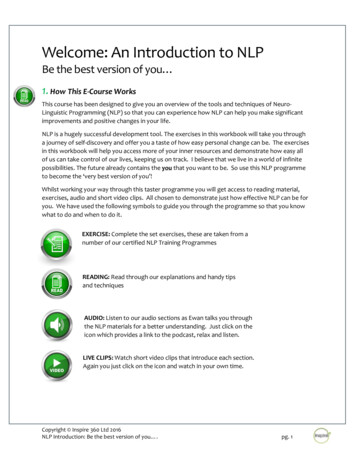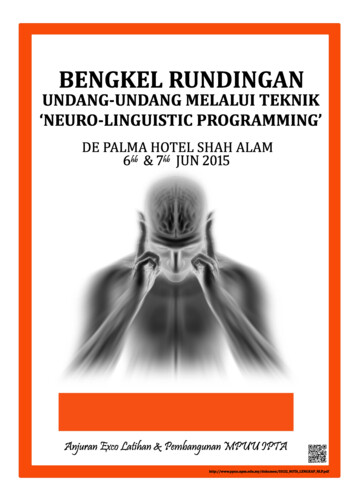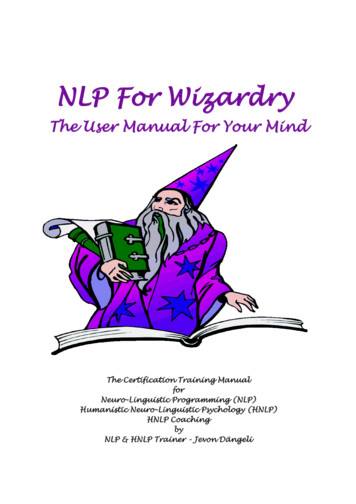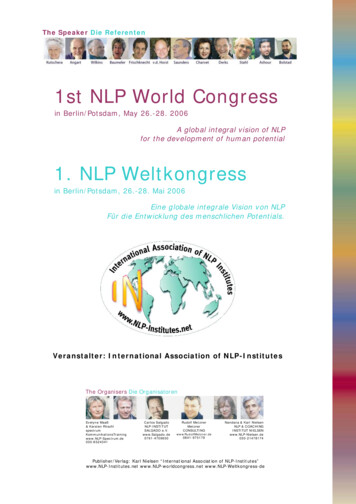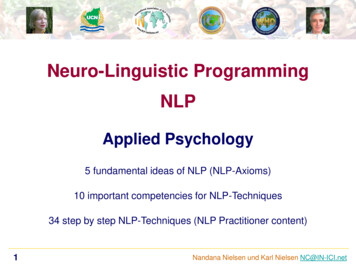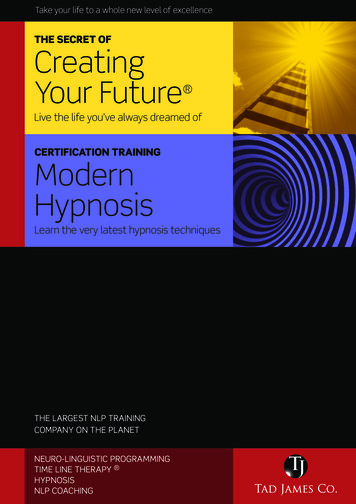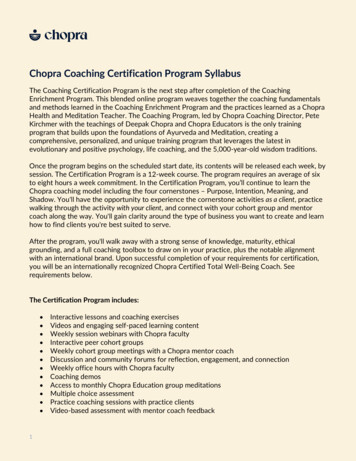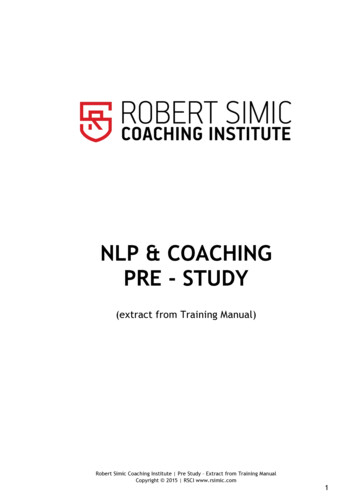
Transcription
NLP & COACHINGPRE - STUDY(extract from Training Manual)Robert Simic Coaching Institute Pre Study – Extract from Training ManualCopyright 2015 RSCI www.rsimic.com1
“Our deepest fear is not that we are inadequate,our deepest fear is that we arePOWERFUL BEYOND MEASURE.We were all meant to shine as our children do.It’s not just in some of us,it’s in EVERYONE.”- Marianne WilliamsonRobert Simic Coaching Institute Pre Study – Extract from Training ManualCopyright 2015 RSCI www.rsimic.com2
Table of ContentsINTRODUCTION. 53 DEFINITIONS OF NLP . 6HISTORY OF NLP . 7SECTION 1 – THE PHILOSOPHY OF NLP . 8PROCESS OVER CONTENT . 9WHAT ARE YOU MADE OF? . 10YOUR NERVOUS SYSTEM . 11YOUR POWERFUL BRAIN . 14HOW WE CREATE OUR REALITY . 15Step 1 – Experience . 17Step 2 – Meaning Making . 18Step 3 – Feeling Making . 19Step 4 - Feedback . 19THE PRESUPPOSITIONS OF NLP . 20UNCONSCIOUS MIND . 26RETICULAR ACTIVATION SYSTEM (RAS) . 26PSYCHO-CYBERNETIC MECHANISM . 27THE AMYGDALA . 28PRIME DIRECTIVES OF THE UNCONSCIOUS MIND . 29YOUR CONSCIOUS MIND . 35EMOTIONS . 367 NATURAL LAWS . 37The Law Of Vibration And Attraction . 38Everything Is Energy . 38THE LAW OF CONTINUOUS TRANSFORMATION OF ENERGY . 39The Law Of Polarity . 40The Law Of Rhythm . 40The Law Of Relativity . 40The Law Of Cause And Effect . 41The Law Of Gestation . 42INTERNAL REPRESENTATION . 43PERCEPTION IS PROJECTION . 46RESPONSIBILITY FOR CHANGE . 49RESPONSIBILITY FOR FINDING VALUE . 50PHYSIOLOGY OF EXCELLENCE . 51SECTION 2 - COMMUNICATION . 52ELEMENTS OF COMMUNICATION . 53THE MECHANICS OF COMMUNICATION . 54PROCESS OF COMMUNICATION. 55Robert Simic Coaching Institute Pre Study – Extract from Training ManualCopyright 2015 RSCI www.rsimic.com3
THE STRUCTURE OF COMMUNICATION. 56Sensory Acuity. 56Rapport. 59Representational Systems . 67Eye Patterns . 75Eye Pattern Chart . 76Eye Pattern Elicitation . 77Intonation Patterns . 79The Conscious Use of Language . 80Presuppositions . 81Hierarchy of Ideas . 85Milton Model . 86Metaphors . 89The Meta Model . 91Detailed Questioning for a Specific Result . 92Reframing . 93The 5 Step Sales Process . 94Negotiating—Influencing . 97The Meeting Format . 101SECTION 8 - NLP GLOSSARY . 103Robert Simic Coaching Institute Pre Study – Extract from Training ManualCopyright 2015 RSCI www.rsimic.com4
INTRODUCTIONWelcome to the exciting world of Neuro Linguistic Programming (NLP). This 6 daypractitioner course is designed to equip you as an NLP practitioner. We will explore thephilosophy of NLP as well as learn several NLP techniques and language tools forapplication in all areas of life.Let’s start this journey by exploring some definitions of NLP. At the end of the trainingplease choose the definition that you feel best matches what NLP really is.Robert Simic Coaching Institute Pre Study – Extract from Training ManualCopyright 2015 RSCI www.rsimic.com5
DEFINITIONS OF NLP1. NLP is an attitude which is an insatiable curiosity about human beings with amethodology that leaves behind it a trail of techniques." Richard Bandler (One ofthe co-founders of NLP)2. It's a set of tools to deal with the blocks—that we've all created—to simply beingwho we really are. Anthony Robbins3. An owner’s manual for the mind – Chris Howard4. The name of the field refers to (Neuro) the human nervous system, including thebrain and the five senses, (Linguistic) the verbal and non-verbal languages withwhich we communicate and (Programming) the ability to structure ourneurological and linguistic systems to achieve desired results – Jamie SmartAll of these definitions are very different from eachother yet all correct. NLP is such abroad subject that it is very difficult to contain it to one single definition.NOTESRobert Simic Coaching Institute Pre Study – Extract from Training ManualCopyright 2015 RSCI www.rsimic.com6
HISTORY OF NLPNLP officially began in the early 1970’s. The following great minds listed below areaccredited with devloping and promoting NLP: John Grinder; originally an assistant of a professor of linguistics at university ofCalifornia.Richard Bandler; holds a BA in Philosophy and Psychology from University ofCalifornia.Fritz Perls; innovative psychotherapist and originator of the school of therapyknown as Gestalt.Virginia Satir; family therapist.Milton Erickson; Internationally acclaimed hypnotherapist.NLP quickly developed into two complementary directions: firstly as a means ofdiscovering and using personal excellence, and secondly as a means of discovering andusing the communications patterns of other people’s excellence.Bandler focused on the work of therapists Virginia Satir and Fritz Perls and began to runvarious workshops and study groups around the subject of gestalt therapy. Soon Bandlerand Grinder began to work together to develop a behavioral syntax for gestalt therapyi.e what skills and techniques would help a person overcome a problem. Adopting anapproach of "if it works, use it - if it doesn't work, try something else" they analyzedwritings and tape recordings to discover the roots of what allowed Satir and Perls toproduce such remarkable results.Ideas, insights, and techniques were tried out on friends who soon joined them indeveloping and extending the work. The enthusiastic and highly creative group grewand this was how NLP developed. Out of this search came many of the techniques andmethods that are still part of good NLP Practitioner and NLP Master Practitionertrainings today, such as anchoring, sensory acuity and calibration, reframing,representational systems Today NLP is still evolving as NLP’ers continueexperimenting with the application of NLP.Like most things, the world of NLP also has its politics. This continues to fuel thedebate of “What is NLP?” and “Who has what rights to claim to be real NLP’rs?”. Ourposition is that anything that can affect the mind and cause change in behaviour can becalled NLP. We like to think of NLP as the art and science of personal excellence.ArtEveryone brings their unique personality and style to what they do,and this can never be adequately explained in words or techniques.ScienceThere are specific clear methods and processes with outcomes thatcan be measuredNLP provides strategies to achieve greater success in all areas of life.Robert Simic Coaching Institute Pre Study – Extract from Training ManualCopyright 2015 RSCI www.rsimic.com7
SECTION 1 – THE PHILOSOPHY OF NLPPhilosphy asks,1. What is there?2. How do we know?3. What is it worth?The Philosphy of NLP suggests a process for1. Understanding what is there2. Determining how we know3. Deciding what its worthRobert Simic Coaching Institute Pre Study – Extract from Training ManualCopyright 2015 RSCI www.rsimic.com8
PHILOSOPHY OF NLPFundamental to the philosophy of NLP is the importance of process over content. Mostapproaches to almost any subject are primarily invested in content even though theprocess is taken into consideration. NLP at its core is interested primarily in process.Content is only helpful in that it helps to determine the context in which processesoccur.PROCESS OVER CONTENTWHYWHATWHAT IFNLP is interested in the “HOW”. It is all about the process that I use to create myreality rather than the details or specifics of my current situation.HOW do I create my WHY, WHAT and WHAT IF?As a result of this approach you will become familiar with statements like . “Once you determine how you create the problem, you can change the process andproduce a different outcome” “If you understand the process someone uses to buy something, you can sell to them byfollowing their process” “Change the order and the sequence of the information presented and change themeaning of the information”Focusing on process is what has led to all the NLP techniques. It is what makes NLP sopowerful and why anyone can get great results practising NLP. This is also one of thereasons this training only needs to be 4 days. We use NLP processes to teach NLP.Another key aspect to the philosophy of NLP is that the answer to the question ‘why’ isreally unimportant. You might be wondering why. Because of the focus on process andon outcomes, it is considered more important to focus on what you want rather than onwhy you created what you didn’t want. Knowing why, also doesn’t necessarily equipRobert Simic Coaching Institute Pre Study – Extract from Training ManualCopyright 2015 RSCI www.rsimic.com9
anyone to go create what they want. At best it can help you not create what you don’twant. The big shift here is all about what thoughts you hold in your mind and whereyour focus is.NLP believes that what you focus on is what you get.One of the major objectives behind NLP techniques is to get you to focus on somethingthat solves the problem. NLP suggests that the problem exists because of what youwere focusing on in the first place.At this point you might be thinking that this is very simplistic and very “off the wall” asNLP seemingly insists on ignoring reality. I can understand that position at this point.All I can ask is that you stick with me as I explain more. In fact the best way I know howto ensure you get the most from this training is to ask you to reserve your judgment tothe end of this training. NLP as a subject often only really becomes clear once you havethe full picture. The information is presented to you in layers and the full picture willonly become clearer further down the line.WHAT ARE YOU MADE OF?A good idea is to understand your client’s presenting problems (how the problem is aproblem) in order to help them. You also need to know what resources are available toovercome these challenges and to deliver your client’s desired results. Knowing whathumans are made of will provide us with great insight on the resources that areavailable to facilitate change. How would you like to learn about your powerful mind,body and your neurology?Chemically speaking, we are made of hydrogen, oxygen, nitrogen and carbon. These arethe same elements that stars are made of. Naturally our chemical construction isdifferent to that of stars even though we share the same basic content.From a biological perspective, you can downsize your body into the following: Systems: Nervous System / Vascular System / Muscular System Organs: Brain / Lungs / Stomach / Skin Tissues CellsRobert Simic Coaching Institute Pre Study – Extract from Training ManualCopyright 2015 RSCI www.rsimic.com10
From a physics perspective you can downsize cells into: MoleculesAtomsSubatomic ParticlesProtons and ElectronsNeurons, Gluons, Quarks and Mesons(electromagnetic vibration waves of light called QUANTA)Most people are familiar with the concept of atoms. Like with many things, most peoplenever bother, or have any interest to look deeper. As illustrated above, when we lookdeeper we realise that our physical existence is fundamentally energy. Look at the listabove again. Notice that every single cell of your body is made up of Molecules, whichin turn is made up of atoms. To date the only scientifically measurable within an atomis energy. That means that every single cell of your body is made of vibrating waves oflight called energy. Fundamentally you are made of energy. In fact you could even goas far as saying you are made of light.Today we know now that every organ, every tissue and every single cell in your body ismade of atoms. The molecular structure as well as the frequency that the atomsvibrate at, is what separates them and makes everything unique and distinguishable.This is why blood is different to muscle even though they are both made of atoms. Inthe same way EVERYTHING else in our physical universe is also made of atoms! Thismeans that your book, chair, car and anything else physical in this world is also madeup of atoms and therefore made of energy.EVERYTHING in our physical universe including the invisible air that you breathe is madeof atoms and therefore made of energy. You might be wondering how this has anythingto do with coaching or NLP? Stay with me as the answer will become very clear to youduring the rest of this training. For now, remember that everything, including you,constantly vibrates at a frequency - emitting energy.YOUR NERVOUS SYSTEMOnce you understand the magnificence of your Nervous System, it is very easy to getexcited about the possibilities of change within yourself and your clients! Your NervousSystem and your neurology is the most magnificent creation known to mankind!Understanding your client’s presenting problem coupled with a realistic idea of what ispossible based on their potential is the first step of the RSCI Coaching process.Understanding your neurology is the key to defining realistic outcomes for yourself andyour clients based on real potential.Robert Simic Coaching Institute Pre Study – Extract from Training ManualCopyright 2015 RSCI www.rsimic.com11
Here is your first task.Define in your own words what a neurological connection is.Your Nervous System is capable of (1010)11 possible neurological connections. That’s thenumber ten, with ten zeros behind it, written eleven times. Here it is:100 000 000 000 000 000 000 000 000 000 000 000 000 000 000 000 000 000 000000 000 000 000 000 000 000 000 000 000 000 000 000 000 000 000 000 000 000000 000 000 000 000 000You might be thinking, great! But what does this mean to us practically? Before Ianswer this question it is well worthwhile contemplating the enormity of this number. This number is so big that we have no conscious idea of what to compare it withYou have more possible neurological connections, although you are not usingthem all, than the number of all the stars in our visible universe.You have more possible neurological connections than the number of all thegrains of sand on all the beaches on our planetYou have more possible neurological connections than all the atoms in the entireuniverse, according to quantum physicists Dr. Paul Goodway.Now knowing our unlimited potential and what is possible, how do we explain a worldof people that struggle to learn new languages, or to achieve their goals, or healdiseases?Being an NLP Practitioner is vastly about understanding how we accept limitations andcreate barriers within ourselves that block this potential. The exciting bit is not that weidentify the challenges but that you are going to learn to unlock this potential and setyourself and your clients free to create the life that you/they want. Be prepared for afun and exciting journey as your potential is unleashed in the world!For decades scientists have believed that we only have neurons in our brains. DepakChopra, in his book called “Quantum Healing” published in 1986, proved that neuronsare actually everywhere in the body. In fact, neuro transmitters bathe every single cellof your body. This means that your brain can and does communicate with any part ofyour body constantly. Your thoughts are communicated to all your cells, all the time.Now, that’s not only interesting, that is also extremely important to us, because thatscientifically proves the mind-body connection! The thoughts that you hold in your mindaffect your body.Have you ever heard the saying “all that stuff is just in your mind”? The good news isthat NLP is not just in your mind! The fact is that the impact of this powerful approachto change affects the body as well. Depak Chopra’s findings now validate the effectthat the mind has on your physical body. This is the first proof in history of the mindbody connection. That’s really, really important to us because it means that thethoughts that you hold in your mind do affect your body. This opens up a number ofpossibilities that I suggest we explore.Robert Simic Coaching Institute Pre Study – Extract from Training ManualCopyright 2015 RSCI www.rsimic.com12
Now that we have discovered your almost inconceivable potential hosted by themagnificence of the body and its neurology, we have a good reason to engage our mindsto focus on tapping into this potential to create new choices. What new choices do wegain by knowing this? By the way, this is always a good question to be asking about anynew learning.The most obvious application of this knowledge is in the area of health. We couldpossibly explain miraculous healings now. We also gain the possibility of healing whatwas not possible for us to consider healing before. Your body has this incredible powerof rewiring, changing, transforming, healing itself of course if we do somethingabout it.Michael Hutchinson’s book, “Mega Brain” written in 1986, tells the story about amedical doctor who had lifelong friend. His friend lived a completely normal life. Hehad a job, a family, kids and a dog. When his friend died, the doctor did the autopsy onhis friend. When he cut open his head, he found that there was no brain?! Yes nobrain?! He had “Hydrocephalus”. The space in the scull for the brain was filled withwater instead. This man had no brain since he was born. He had the brain stem, and avery, very thin layer of brain cells, but inside of that was all water-like fluid, no brain!You might find this funny. There was a conference in Montreal for medical doctors, andmy friend was teaching them hypnosis. After he shared this story about the man wholived a normal life with no brain, one doctor raised his arm and said that he did anautopsy on his father who also didn’t have a brain. Nobody told these people that theyhad no brains. Their ignorance allowed them to lead normal lives! The doctor’s fatherwas actually excellent in maths and an outstanding chess player!!!You can’t help but wonder how this is possible. Based on what we have learnt so far wecan conclude that the physiology of the nervous system, from top to toe, rewired itselfto compensate for the absent brain. In very simple terms, the functions of the brainwere reassigned. Do you think that these people would have been able to live normallives if they were told that they don’t have a brain at some point?This does lead us to the conclusion that our beliefs significantly impact our behaviour aswell as expectation of behaviour. If a kid is continuously told: “You are stupid, you arestupid, you are stupid”, the kid will decide to adopt this as a belief at some point.People by nature actualize behaviour that supports and enforces their beliefs (by theway, none of the kids I have EVER worked with were stupid – there is no such thing as akid that can’t learn, there is no such thing as a kid that is not a genious).Remember that you are a magnificent being with the most powerful Nervous Systemthat has incredible potential, potential beyond measure and this leads me to believethat EVERYTHING is possible for you.Robert Simic Coaching Institute Pre Study – Extract from Training ManualCopyright 2015 RSCI www.rsimic.com13
YOUR POWERFUL BRAINTake a few seconds and contemplate these facts 98% of our knowledge about the human brain has been learned in the last 10years!80% of everything that scientists knew about the brain by 1990 is today proven tobe false!What incredible statements. It just proves that what we don’t know – we don’t know. Italso proves that what we do know it may just as well be proven false as we learn newthings. Scientists usually believe strongly in their findings, until they become obsoleteby discovering the unknown. Modern technology and new devices make it possible forresearchers to continue beyond what we ever thought possible before. As a result ourknowledge will continue to expand, our perceptions will continually change. This willimpact all aspects of our world including the medical and wellness industries.Think about it, until 1990 doctors were taught that our brain is hard-wired. Thanks tomodern science and devices developed, we can now monitor the human brain while stilloperational - alive, seeing exactly which part of the brain is involved in whichfunctions. That is how they discovered that the brain is not hard-wired! It changes andcreates new neural-pathways – makes new connections, retracting the old ones. This iscalled brain plasticity.We also learned that our thoughts are real! It’s not just a thought, it’s a material thing,made of energy (they are bioelectrical and biochemical impulses) and better yet,thoughts are the most potent energy known to us!Some brain research facts: When 10% dehydrated – it’s 50% less efficient!!!It has 160,000 kilometres of blood vesselsIt is always on – it never rests throughout your whole lifeOne brain cell is more complexly wired than the entire telephone network of theworldWe were not born hard-wired!100 Billion neurons – as many stars as are in the Milky WayGenius ability in every one of usCapable of 10,000 Trillion operations per secondWe are limitless in capacity to learn and grow fast! At least 1000 times faster than the fastest supercomputer in the world!Robert Simic Coaching Institute Pre Study – Extract from Training ManualCopyright 2015 RSCI www.rsimic.com14
HOW WE CREATE OUR REALITYAs we are on the subject of reality, let’s explore what NLP has to say about reality andhow it is created.STEP 1 – EXPERIENCEIs to understand that our reality is informed by sensory information/data. Thisinformation is neutral and entirely meaningless.STEP 2 – MEANING MAKINGIs the process by which meaning and value is assigned to the sensory data. NLPsuggests that these processes are informed by your “model of the world”.STEP 3 – FEELING MAKINGIs the interaction between your internal reality and your physiology to produceyour state.STEP 4 – FEEDBACK1. eeling!making!processes!2. Our!Results!–!As!feedback!to!our!bahaviour!3. t Simic Coaching Institute Pre Study – Extract from Training ManualCopyright 2015 RSCI www.rsimic.com15
PROCESSES OF CREATING OUR REALITYEXTERNAL1INTERNAL2EXPERIENCEDELETESENSORY DATA!!!!!MY CONDITIONINGFEELING MAKINGMY BODYCORE FOCUS FILTERS- Internal E4MY RESULTS3MEANING MAKINGPROCESS FOCUS FILTERS- Rules- PersonalityKEY FOCUS FILTER- Internal EvaluatorMY i-REALITYMYSTATEFEEDBACKMY BEHAVIOURRobert Simic Coaching Institute Pre Study – Extract from Training ManualCopyright 2015 RSCI www.rsimic.com16
STEP 1 – EXPERIENCEWe are all reliant on our 5 physical senses to experience anything. Some people preferusing one sense over the others. Some people are better at using one specific sensethan what they are at using the others. When someone has a disability in any onesensory area they compensate by developing above average skills in another sensoryarea.SENSESSmellTasteFeelTouchSeeOur senses provide us with data, data that is neutral in meaning. Sensory data allowsme to acknowledge the existence of my dog. Sensory data does not determine what mydog means to me, or how I feel about my dog right now. Sensory data allows me toexperience my dog barking. My response to the barking is based on my meaning andfeeling making processes.It is also worth noting that our 5 physical senses are limited in nature. Yes, we can see,but there is so much more to see that we don’t! We can smell, but there is so muchmore to smell – ask my dog! They can smell so much more than we do!The diagram below illustrates our visual ltravioletX RayGamma rayInvisibleLow FrequencyHigh FrequencyLow EnergyHigh EnergyOur senses are our gateway to the world. They process and deliver the information weuse to create our perceptions and construct our reality. Quantum scientists todaybelieve that our 5 senses are processing approximately Four Hundred Billion(400,000,000,000) bits of information per second. That is a lot of information for ourminds to process!Knowing that our reality is impacted by the limitation of our senses is really good news.It means that there are things that we might not know yet, that could make asignificant difference in our lives. NLP is very invested in exploring your relationshipRobert Simic Coaching Institute Pre Study – Extract from Training ManualCopyright 2015 RSCI www.rsimic.com17
with your senses as well as how we improve our communication by understanding andadapting to the sensory preferences or strengths of others.STEP 2 – MEANING MAKINGComing to grips with our meaning making process is learning what exactly happens tothe sensory data as we process it. How specifically does the same meal become a goodexperience for one person and a bad experience for another?NLP is very invested in the models and techniques that help identify and change theseaspects of how we create our internal reality. We learn to take a new look at how weinterpret our worlds. In its simplest form we make meaning by performing 3 mainfunctions on the sensory data we process:1. DeleteOur sensory data of four hundred billion bits per second needs to be reduced toapproximately two thousand bits per second for us to be able to consciously process ourexperience. This means that most of what our senses process is lost. You can probablyremember some of the things you did yesterday. All the other moments are deleted andthe things that matter to you are what you will remember. How many red cars drovepast you in the traffic this morning? I am sure you saw them and just deleted them.Lets consider for a second what we don’t delete. If someone has the same pair
Welcome to the exciting world of Neuro Linguistic Programming (NLP). This 6 day practitioner course is designed to equip you as an NLP practitioner. We will explore the philosophy of NLP as well as learn several NLP techniques and language tools for application in all areas of life.

